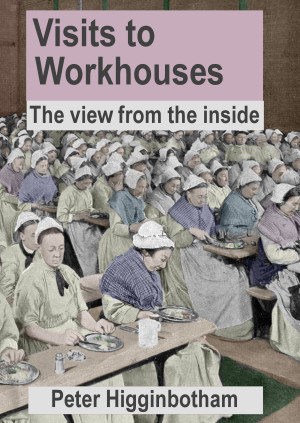Workhouse Inspections and Visits
Much useful information about workhouses and their operation can be gleaned from the reports provided by those conducting formal inspections of the establishments. After 1834, inspectors from the central Poor Law authority visited each workhouse once or twice a year and their reports can be found in the MH12 section of the National Archives (TNA), with copies also sometimes found in the relevant local archive repositories.
An extensive series of reports on unnamed workhouses was made for the 1905 Royal Commission on the Poor Laws. These were included in the massive volume of evidence published by the Commission but the institutions concerned were not named. Many of these locations have now been identified and some of their reports are included in my book Visits to Workhouses: the View from the Inside.
Important series of inspections were also carried out by the medical journals The Lancet (in 1865-7) and the British Medical Journal (in 1894-6) as parts of campaigns to improve conditions in workhouse medical facilities. The former series focuses on London workhouses, while the latter includes visits to workhouses in Ireland. Individual campaigners such as Joseph Rowntree also published accounts of their own visits.
Surprisingly, perhaps, workhouses were often happy to give a tour of their premises to journalists, such as Charles Dickens, and even to merely curious passers-by. Their subsequent accounts often reveal unexpected detail about life on the inside. In 1844, for example, a German traveller, J.G. Kohl, paid a visit to the North Dublin Union workhouse and detailed how large quantities of potatoes were cooked and served for the inmates' dinner. Undercover visits to workhouses, especially their casual wards, were described by a number of so-called Social Explorers.
- Workhouse Inspection reports available at TNA
- Lancet Reports (1865-7)
- British Medical Journal Reports (1867)
- British Medical Journal Reports (1894-6)
- Joseph Rowntree's Reports (1859-1868)
- Emma Brewer's Reports (1889-90)
- H. Stuart Baker's Reports (1910-12)
- Journalism
- Social Explorers
 Visits to Workhouses includes over 50 first-hand accounts of visits to workhouses by journalists, inspectors, campaigners, 'social explorers', and authors such as Charles Dickens. Reports are also included for some previously unidentified workhouse sites visited by the 1905 Royal Commission on the Poor.
These reports, many of which are not available online, often reveal fascinating detail about these institutions and the lives of their inmates. More details....
Visits to Workhouses includes over 50 first-hand accounts of visits to workhouses by journalists, inspectors, campaigners, 'social explorers', and authors such as Charles Dickens. Reports are also included for some previously unidentified workhouse sites visited by the 1905 Royal Commission on the Poor.
These reports, many of which are not available online, often reveal fascinating detail about these institutions and the lives of their inmates. More details....
Unless otherwise indicated, this page () is copyright Peter Higginbotham. Contents may not be reproduced without permission.


